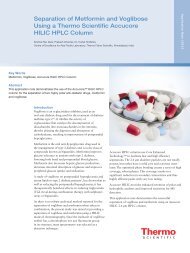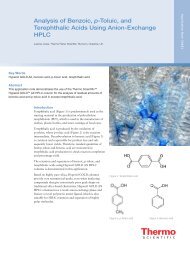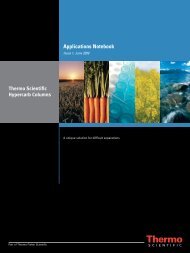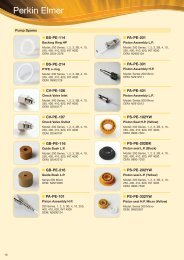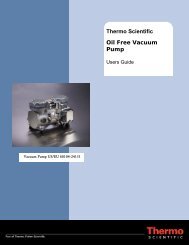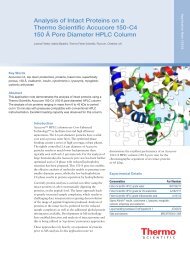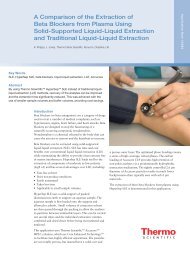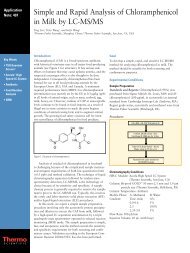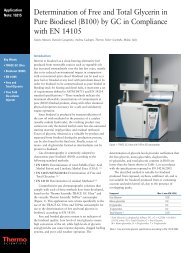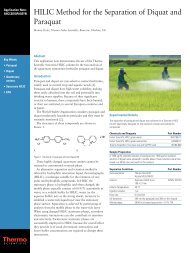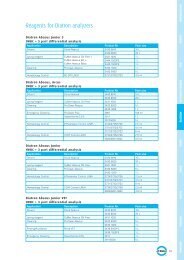Rocket Columns
Rocket Columns
Rocket Columns
You also want an ePaper? Increase the reach of your titles
YUMPU automatically turns print PDFs into web optimized ePapers that Google loves.
Optimum Efficiency, Selectivity, Capacity<br />
All successful separations require column efficiency,<br />
selectivity and capacity. <strong>Rocket</strong> <strong>Columns</strong> have all three in a<br />
package that delivers unprecedented resolution and speed.<br />
Efficiency<br />
<strong>Rocket</strong> <strong>Columns</strong> are packed with 3µm or 1.5µm spherical<br />
particles that produce more than 120,000 or 200,000 plates/<br />
meter, respectively. Our most efficient <strong>Rocket</strong> Column, a 53 x<br />
7mm column packed with 1.5µm Platinum media, generates<br />
nearly 300,000 plates/meter - unprecedented for any HPLC<br />
column! These high efficiencies let <strong>Rocket</strong> <strong>Columns</strong> deliver<br />
the resolution of much longer columns in a fraction of the run<br />
time.<br />
Selectivity<br />
Controlled silica exposure is the difference that makes<br />
Platinum columns unique. The approach taken by most column<br />
manufacturers in making base-deactivated reversed-phase<br />
columns is to thoroughly cover the silica with bonded phase to<br />
minimize any interaction between polar analytes and the packing<br />
medium’s silica backbone. With our Platinum media we have<br />
taken a different approach. Instead of maximizing the coverage<br />
of bonded phase to hide the silica, we have controlled the<br />
exposure of the silica to provide a dual mode separation<br />
medium with both polar and non-polar sites exposed to your<br />
samples. This extends polar selectivity well beyond what other<br />
reversed-phase columns offer and gives separations other<br />
columns can’t.<br />
Use Standard Platinum <strong>Columns</strong> for neutral and moderately<br />
polar compounds and Platinum EPS <strong>Columns</strong> (Extended<br />
Polar Selectivity) for highly polar compounds with two or more<br />
functional groups. Platinum EPS <strong>Columns</strong> have added<br />
selectivity and capacity for polar analytes (Figure 3). This<br />
powerful combination solves many reversed-phase separation<br />
problems.<br />
<strong>Rocket</strong> <strong>Columns</strong> are also available filled with other popular,<br />
high-quality 3µm materials for quick, convenient acceleration of<br />
existing methods. Simply use a <strong>Rocket</strong> Column filled with the<br />
3µm version of your method’s packing material and watch run<br />
times shrink by 70 to 80%!<br />
Capacity<br />
<strong>Rocket</strong> <strong>Columns</strong> accept high sample loads for easy detection<br />
of impurities and minor components in the presence of major<br />
peaks. 1.5µm <strong>Rocket</strong> <strong>Columns</strong> often produce 200,000-300,000<br />
plate/meter efficiencies even at high sample loading levels.<br />
<strong>Rocket</strong> <strong>Columns</strong> use fully porous packing materials that<br />
maintain capacity and efficiency as sample mass increases,<br />
conditions where non-porous silica (NPS) columns fail (Figure 4).<br />
<strong>Rocket</strong> Platinum Packings Offer You a<br />
Selectivity Choice<br />
8678<br />
8679<br />
Standard Platinum <br />
Platinum EPS<br />
1<br />
NOTE<br />
The elution order<br />
changes between<br />
Standard Platinum“<br />
and Platinum“ EPS.<br />
1<br />
2<br />
3 4 5<br />
1. Xanthine<br />
2. Theobromine<br />
3. Theophylline<br />
4. Caffeine<br />
5. 8-Chlorotheophylline<br />
<strong>Rocket</strong> Column’s Porous Media Maintains<br />
Performance as Sample Mass Increases<br />
8700<br />
8699<br />
<strong>Rocket</strong> Platinum 100Å<br />
C18, 1.5µm, 33 x 7mm<br />
Non-porous Silica (NPS)<br />
C18, 1.5µm, 33 x 4.6mm<br />
NOTE<br />
At high sample<br />
loads, peak<br />
shapes and<br />
resolution degrade<br />
rapidly on<br />
non-porous media.<br />
1<br />
2<br />
3<br />
1<br />
2<br />
1. Dimethyl phthalate<br />
2. Diethyl phthalate<br />
3. Dipropyl phthalate<br />
4. Dibutyl phthalate<br />
3<br />
4<br />
4<br />
2<br />
3 4 5<br />
0 1<br />
Column: 100Å C18, 3µm, 33 x 7mm <strong>Rocket</strong> Column<br />
Mobile Phase: 0.010M Sodium Acetate, pH4.0:Methanol (70:30)<br />
Flowrate: 5.0mL/min<br />
Detector: UV at 254nm<br />
Figure 3<br />
2 Min.<br />
0 1<br />
Mobile Phase*: Chrom 8700: 0.015M Sodium Acetate<br />
pH4.5:Acetonitrile (35:65)<br />
Chrom 8699: 0.015M Sodium Acetate<br />
pH4.5:Acetonitrile (65:35)<br />
Flowrate: 1.0mL/min<br />
Injection: 3.0µg in 5µL<br />
Detector: UV at 254nm<br />
*Mobile phases adjusted to produce equivalent run times.<br />
Figure 4<br />
2<br />
3 Min.<br />
© Copyright 2001 Alltech Associates, Inc.<br />
Contact your Alltech office or distributor for current or local prices.<br />
4



